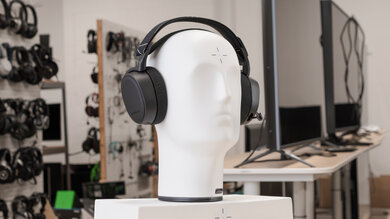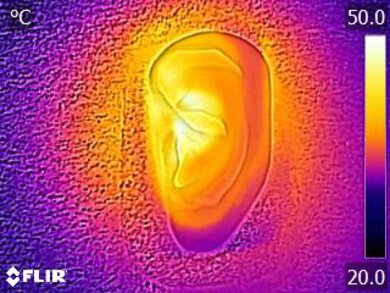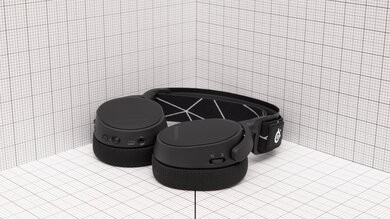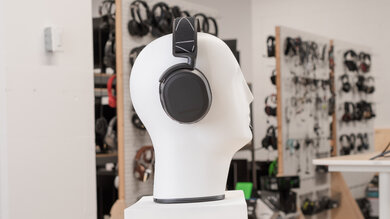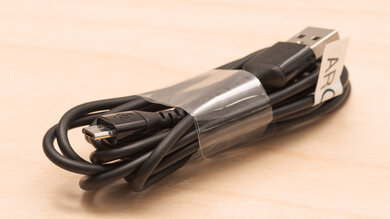The SteelSeries Arctis 9 Wireless are feature-packed wireless gaming headphones. Like many other SteelSeries headsets, they have a stretchy ski-band headband design that helps distribute their weight. They offer Bluetooth compatibility, a high-quality boom microphone, and companion software with a broad range of configuration options. These headphones are for PC and PlayStation. If you're an Xbox gamer, the SteelSeries Arctis 9X Wireless are essentially the same headphones for that console.
Our Verdict
The SteelSeries Arctis 9 aren't designed for neutral sound out of the box. Their default sound lacks low-bass, so mixes are missing some thump and rumble. They have some extra high-bass that helps emphasize sound effects like footsteps and explosions in games. Thankfully, their mid-range is well-balanced, so vocals, dialogue, and lead instruments sound clear and present. Their companion software also features a graphic EQ and audio presets to customize your listening experience. However, they deliver audio inconsistently, so you have to adjust them to get the same sound every time you use them.
- Feature-packed companion app with graphic EQ.
- Impressive build quality.
- Inconsistent audio delivery.
- Closed-off passive soundstage.
The SteelSeries Arctis 9 are alright for commuting and traveling. Since they're Bluetooth-compatible, they don't need their wireless transmitter to function, so you can listen to your music on your phone during your daily commute. They have 20-hour continuous battery life for longer journeys. Unfortunately, they have a bulky design and don't block out much background noise, so it might be hard to hear your audio over the sound of rumbling engines and passenger chit-chat.
- Good battery life.
- Impressive build quality.
- Compatible with Bluetooth.
- Poor noise isolation capability.
- Bulky, heavy design.
- Tight fit won't suit all listeners.
The SteelSeries Arctis 9 aren't designed for sports and fitness. They have a tight fit that gives them better stability than many gaming headsets, but they can still slip out of place if you move around a lot. They're also quite heavy and aren't rated for dust or water resistance, like most over-ear headphones.
- Good battery life.
- Impressive build quality.
- Bulky, heavy design.
- Tight fit won't suit all listeners.
The SteelSeries Arctis 9 are adequate for office use. They're comfortable enough to wear for long periods and supply more than 20 hours of playback, so they can last you through the whole workday without a problem. However, they don't filter out that much background noise, so you'll hear the chatter of coworkers.
- Good battery life.
- Compatible with Bluetooth.
- Poor noise isolation capability.
- Tight fit won't suit all listeners.
The SteelSeries Arctis 9 are a good choice for wireless gaming. Their USB transmitter allows for low-latency audio while their simple control scheme lets you quickly adjust chat mixing on the fly. They have a companion app with a wide range of features to let you fine-tune your gaming experience as well as a high-quality boom microphone that ensures teammates hear you clearly.
- Feature-packed companion app with graphic EQ.
- Great microphone recording quality and noise handling performance.
- Low wireless latency with USB dongle.
- Inconsistent audio delivery.
- Tight fit won't suit all listeners.
The SteelSeries Arctis 9 don't come with an audio cable but are partially compatible with wired connections since they have a 3.5 mm audio port. If you have a 1/8" TRS or TRRS cable, you can receive audio from PC, PS4, PS5, Xbox One, and Xbox Series X systems, but you can't use their mic.
The SteelSeries Arctis 9 are decent for phone calls. Their boom microphone does a great job of making your voice sound full-bodied, clear, and mostly free of background noise. They don't isolate you from much background noise, so it'll be hard to follow a conversation if you call from a loud environment.
- Great microphone recording quality and noise handling performance.
- Poor noise isolation capability.
Changelog
- Updated Jan 18, 2024: We've made minor edits to the text to keep it current.
- Updated Nov 01, 2021: Converted to Test Bench 1.5.
- Updated Sep 22, 2021: We've retested 'Multi-Device Pairing'.
- Updated Mar 25, 2021: We've tested 'Breathability' as well as PS5 and Xbox Series X compatibility. We have also updated the Wired 'Analog Audio' results for clarity and added more information to 'Sound Profile' regarding driver mismatch.
Check Price
Differences Between Sizes And Variants
The SteelSeries Arctis 9 Wireless come in only one color scheme: 'Black'. You can see the label for the model we tested here.
If you come across a differently-equipped variant, let us know in the comments, and we'll update our review.
Popular Headphones Comparisons
The SteelSeries Arctis 9 are premium wireless gaming headphones that are essentially the PC/PS4 version of the SteelSeries Arctis 9X Wireless. They offer impressive build quality, a 20-hour battery life, and Bluetooth compatibility, so you can stream music from your phone while gaming. Unfortunately, they do a poor job of blocking out background noise and are quite bulky.
For alternatives, look at our list of recommendations for the best wireless gaming headsets, the best PS4 gaming headsets, and the best gaming headsets.
The SteelSeries Arctis Nova 7 Wireless and their variants are better gaming headphones than the SteelSeries Arctis 9 Wireless. While both headphones are comfortable, the Nova 7 and its variants have a longer continuous battery life. They also come with an analog cable if you want to use them wired, and they have full compatibility with PCs and consoles via this connection. The Arctis 9 are better built.
Depending on your preferences, you may want to check out either the SteelSeries Arctis 7+ Wireless or the SteelSeries Arctis 9 Wireless. The Arctis 7+ are more customizable headphones as they're compatible with Sonar, which is a software integrated inside SteelSeries GG companion software, offering even more features. It offers a parametric EQ and presets as well as adjustable levels for microphone and chat control. These headphones are also compatible with PlayStation 5's Tempest 3D AudioTech, which can help create a more immersive audio experience. However, the Arctis 9 support Bluetooth, which is good if you want to stay connected to your console and smartphone at the same time. They have slightly less non-Bluetooth wireless latency and better microphone performance.
The SteelSeries Arctis Pro Wireless are more versatile than the SteelSeries Arctis 9 Wireless. The Arctis Pro block out more ambient noise, have a better-performing boom microphone, and last longer on a single charge. They also come with a 1/8" TRRS cable that allows for full audio and microphone compatibility via analog connections and their wireless latency is lower too. However, the Arctis 9 have a broader range of microphone volume adjustments in their companion software.
The SteelSeries Arctis 7 2019 Edition Wireless are slightly better for wireless gaming than the SteelSeries Arctis 9 Wireless. The 7 2019 Edition have a 1/8" TRRS cable that allows for passive audio playback and microphone usage. They also deliver audio more consistently and have a better-balanced default sound profile. Their continuous battery life is longer too. Meanwhile, the 9 are Bluetooth-compatible, so you can listen to music from your phone as you game. They also have an easier-to-use control scheme.
Test Results

They have a comfortable fit. The ear cups offer a pretty broad range of adjustability and have soft cloth-covered padding. While the headset is somewhat heavy, the elastic headband does a good job of distributing its weight. Unfortunately, like other SteelSeries headphones, the headband can feel tight if you have a larger head.
They have a very good control scheme. There are dedicated buttons for power on/off, microphone muting, and Bluetooth playback functions. You hear audio feedback when the mic is muted and unmuted, and there's a red light on the mic that illuminates when it's muted to make it even easier to tell if the mic is active. However, the controls would be easier to use if the volume and Chatmix dials had middle notches.
On the right ear cup:
- Volume wheel
- Adjusts volume
- Microphone mute button
- Mutes and unmutes microphone
- Bluetooth button:
- Single press: Play/pause audio or answer/end a call
- Double press: Skips to the next track
- Triple press: Skips to the previous track
On the left ear cup:
- Chatmix dial
- Adjusts chat/game audio levels
They have sub-par breathability. While the material covering the ear cups feels similar to that of the SteelSeries Arctis 9X Wireless, these headphones seem to trap in a bit more heat and don't allow for much airflow. If you wear them during sports or physical activity, they can cause you to sweat more. However, it won't be much of a problem if you're just sitting down to game.
These headphones aren't designed to be portable. The ear cups swivel to fold flat, but their headband doesn't fold inwards to reduce their footprint. Thankfully, since they're Bluetooth-compatible, you won't need to carry their USB transmitter wherever you go. They also have a retractable boom mic, which helps avoid snags when putting them into or taking them out of your bag.
These headphones have impressive build quality. They feel better built than the SteelSeries Arctis Prime and are mostly made of dense, high-grade plastic. They also have cloth-lined ear cup padding as well as an elasticized headband. Overall, they feel like they'll survive a few minor impacts without serious damage, though their yokes and hinges feel a little fragile.
They have good stability. Their ski-band headband and relatively tight fit help keep them in place if you make small head movements when sitting and gaming. However, if you make intense or exaggerated movements, they can slip off. On the plus side, their wireless design eliminates the risk of having an audio cable snag on something and pulling them from your head.
They have a somewhat imbalanced sound profile out of the box. They're missing a bit of low-bass, so some sound effects and bass-heavy music genres lack thump and rumble. While their mids are mostly flat and neutral, they have an uneven treble response that results in a lack of detail and clarity. This isn't helped by the mismatch between the L/R drivers of our unit, which is most noticeable in the low-bass, high-mid, and low-treble ranges. We could also hear a difference in bass delivery between drivers. However, this may be an issue with our unit. Please let us know if you've experienced this issue in the comments below. If you prefer to tweak their sound, it can be customized in-depth via a graphic EQ or presets in their companion app.
They have poor frequency response consistency. Their audio delivery heavily depends on their fit, seal, and positioning, so you may have trouble achieving a consistent listening experience, especially if you have long hair or wear glasses.
They have decent bass accuracy. The low-bass range is underemphasized to different degrees in the left and right drivers, so you won't feel the deep thump and rumble of sound effects like explosions. This is particularly noticeable in the left driver of our unit. On the other hand, they have an overemphasized high-bass response that adds a bit of muddiness to some tracks. That said, since their audio delivery heavily depends on their fit and positioning and the imaging varies from unit to unit, you may have a different experience.
They have great mid accuracy. The range itself is mostly flat, resulting in full-bodied and present dialogue, vocals, and lead instruments. However, there's a mismatch between our unit's left and right drivers. In the right driver, a dip from mid-mid to high-mid makes vocals and instruments sound distant.
Their treble accuracy is sub-par. There's significant mismatch between the L/R drivers in this range, so vocals and lead instruments sound alternatively dull and lispy, though this may only be an issue for our unit. Since their audio reproduction is heavily dependent on their fit and positioning, your experience may vary.
The SteelSeries Arctis 9's peaks and dips performance is satisfactory, so the headphones can control their sound profile well, although there are some notable deviations. The left driver has an underemphasized low-bass response, resulting in a lack of thump and rumble, followed by a bump in the high-bass range that muddies some mixes. The overemphasized mid-mids and high-mids generate some harshness, while the sharp dip and following peak in the treble range make some notes alternatively dull and piercing. The right driver has a slightly recessed mid through high-mid range as well as a slightly harsh low-treble range.
The SteelSeries Arctis 9's stereo imaging performance is mediocre. Their weighted group delay falls beneath the audibility threshold, resulting in tight bass and transparent treble. While the L/R drivers are well-matched in regards to phase response, some amplitude and frequency mismatch is present. This impacts the headphones' ability to accurately place objects in the stereo image. However, these results are only valid for our test unit; yours may perform differently.
These headphones have a passable passive soundstage. Sound seems to come from the room around you rather than from inside your head, and you'll perceive the soundstage as quite spacious. However, it also seems somewhat unnatural and less open compared to open-back alternatives like the Astro A40 TR Headset + MixAmp Pro 2019.
The SteelSeries Arctis 9 have support for DTS Headphone:X 7.1, a virtual surround sound feature meant to create a more 3D, immersive soundstage, so sound effects like footsteps are accurately placed.
They have a satisfactory weighted harmonic distortion performance. There's some distortion in the low-treble that's noticeable at normal or higher volumes. However, it's only present in the left driver of our unit, and most of the frequency range falls within good limits, resulting in mostly clean and pure audio reproduction.
These are the settings used to test the SteelSeries Arctis 9. Our results are only valid when you use them in this configuration.
These headphones have bad noise isolation capability, which is normal for gaming headphones without an ANC feature. They filter out almost no ambient noise in the bass range, so you'll hear noise like traffic outside your window. They also do a poor job in the mid-range, so they won't block out much background chit-chat. Thankfully, they're quite effective at cutting down higher-pitched sound, which is good news if you have a noisy computer fan.
They have a decent leakage performance. If you like to crank up the volume, others in the room can hear some of your game audio.
The microphone's recording quality is great. Your voice sounds clear, natural, and mostly free of distortion.
The microphone's noise handling performance is good. The person you're talking to can hear background noise on a call, but the mic can separate your voice enough that you're easily understood, even if you're in a loud environment.
They have a great battery performance. They supply over 20 hours of continuous use on a single charge and have an auto-off timer to help conserve power that you can adjust in their companion app. On the downside, they take over 5.5 hours to recharge, which is longer than alternatives like the SteelSeries Arctis 7 2019 Edition. Also, battery performance varies depending on how you use the headphones.
These headphones are compatible with the SteelSeries Engine companion software. It's easy to use and offers support for functions like a graphic EQ, audio presets, mic volume adjustment, changing the length of their auto-off timer, and enabling surround sound.
The SteelSeries Arctis 9's Bluetooth connectivity is excellent. They don't offer multi-device pairing solely via Bluetooth, but you can connect to your PC with their USB dongle and stream media via Bluetooth from your phone at the same time, unlike non-Bluetooth-compatible alternatives like the ROCCAT Elo 7.1 Air Wireless. Their latency on iOS and Android mobile devices is low enough to make them suitable for watching videos without significant audio delay. Since apps and devices compensate differently for latency, your real-world experience may vary.
These headphones deliver good non-Bluetooth wireless connectivity. When using their USB transmitter, their latency is low enough to use them for gaming without experiencing significant audio delay.
They don't come with an audio cable, but they have a 3.5 mm jack that allows you to use them with a 1/8" TRS or TRRS audio cable for passive audio playback or sharing audio with another pair of headphones. If you're looking for a wireless gaming headset that already comes with a 1/8" TRRS cable, consider the Sony PULSE 3D Wireless.
These headphones are compatible with a PC using their USB transmitter or via analog connection, provided you have a 1/8" TRS cable.
They work with PlayStation consoles using the wireless transmitter. You can also use an analog cable to receive audio, but none comes in the box.
The SteelSeries Arctis 9 Wireless are only partially compatible with the Xbox One and Xbox Series X consoles when using a 1/8" TRS or TRRS cable and plugging them into your Xbox's controller. However, this cable isn't included in the box and can only receive audio, so you won't be able to use their mic. If you're an Xbox gamer, check out the Xbox version of these headphones, the SteelSeries Arctis 9X Wireless, which have full wireless compatibility with that console.

